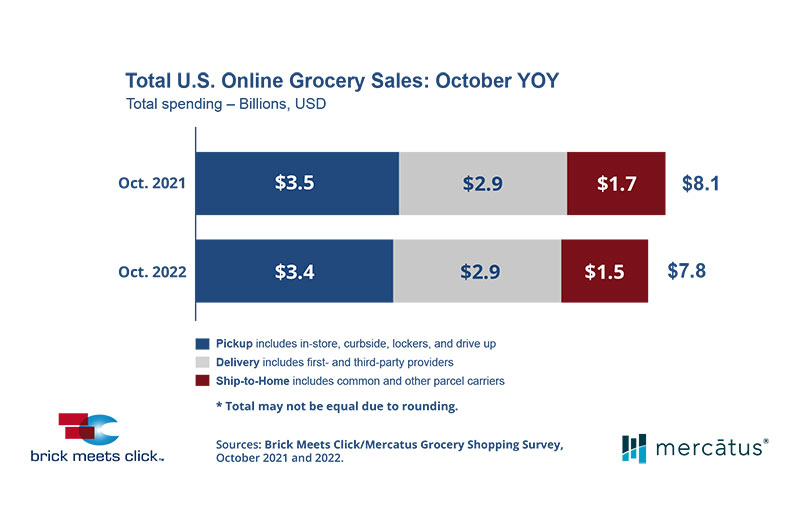The U.S. online grocery market finished October with $7.8 billion in sales, down 3 percent compared to a year ago and flat versus the prior month, according to the monthly Brick Meets Click/Mercatus Grocery Shopping Survey fielded Oct. 28-29.
While year-over-year decline was similar to the prior month, October’s results were driven by different factors, including changes in spending per order, order frequency and monthly active users, that were not evenly distributed across the leading retail formats like mass and grocery.
“Beneath the top-line results, the monthly active user base grew much faster for mass than for grocery versus last year, which may be driven to some degree by inflation’s impact on household spending, but it also reflects the ability of mass to provide a better shopping experience,” said David Bishop, partner at Brick Meets Click.
“Improving the shopping experience is vital for conventional supermarkets’ long-term success as the appeal of shopping online has more to do with convenience than cost.”
During October, all three segments experienced slowdowns in spending per transaction, declining 5 percent in aggregate versus the same period last year. Ship-to-Home’s average order value contracted the most, dropping nearly 11 percent versus a year ago; delivery’s AOV slipped more than 7 percent and pickup’s dipped just more than 3 percent during the comparable periods.
This broad-based downturn in online grocery spending suggests that customers are either shifting some purchases offline and/or buying fewer items in general, due to a challenging economic outlook combined with persistent price inflation.
The overall eGrocery MAU base, which encompasses users of pickup, delivery and ship-to-home, grew by 10 percent in October on a year-over-year basis but slipped slightly versus last month. Each segment experienced growth in its respective MAU base, driven by a 10 percent gain for delivery, followed by an almost 8 percent lift for pickup and a nearly 6 percent bump in ship-to-home users.
Although the difference between the MAU base for October and September may reflect the impact of less-frequent customers who cycle in and out of online grocery shopping, the positive trends across the board highlight a larger customer base that retailers can nurture to unlock additional, latent demand.
The effects of persistent price inflation were evident in total grocery spending as the average dollars spent on groceries per household during the last week of October increased 15 percent versus last year. During that period, online’s share of spending dipped around 50 basis points, accounting for 11.6 percent of total grocery sales in October of this year.
“As grocery retailers look to strengthen their share of monthly active online grocery shoppers, they should focus on working smarter, not harder,” said Sylvain Perrier, president and CEO, Mercatus. “This means making sure that your assortment is accurately reflected online, the online ordering process is engaging and streamlined, and there are no unfortunate surprises for customers during the order assembly and receiving process.”
For additional insights and information about the full report, visit the eMarket/eShopper page.

